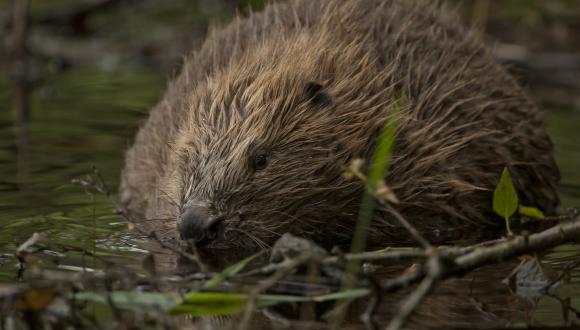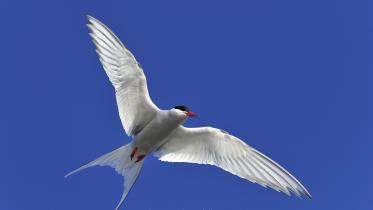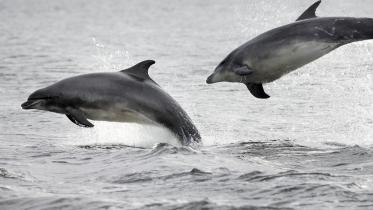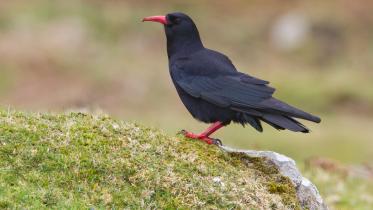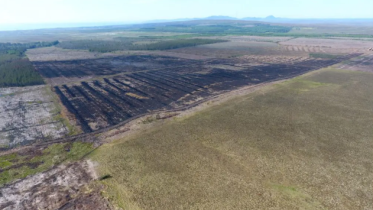Decision document - License application 221326 - Possession, Control, Transport and Release of Eurasian Beavers at Aber Burn, The Royal Society for the Protection of Birds (RSPB), Loch Lomond National Nature Reserve (NNR)
Purpose of this document
This decision document:
- Explains how the application has been assessed;
- Provides a record of the decision-making process;
- Details how all material considerations as outlined in the Scottish Code for Conservation Translocation have been considered;
- Details the specific conditions added to the licence, in addition to our generic licence conditions.
Key factors of the assessment
1. Application summary
An application was received by NatureScot on 7th October 2022 for the release of Eurasian beaver (Castor fiber) at Aber Burn, on land owned and managed by The Royal Society for the Protection of Birds (RSPB), within Loch Lomond National Nature Reserve (NNR).This site is on the edge of the current beaver range and the application aims to reinforce the local population. Beavers will be trapped following best practice under a separate licence, number 222487, and will be health screened before being transported for release. All beavers trapped will be obtained from locations already covered by a NatureScot licence for removal associated with human-beaver conflict. This beaver reinforcement project is proposed as an alternative to translocation to sites in England or Wales or to lethal control at sites where mitigation measures are not feasible or have not been successful in resolving the human-beaver conflict and is proposed as an action that will bring benefits to the beaver population and wider environmental benefits.
2. Our final decision
NatureScot Licensing Officers have undertaken a full assessment of the proposal to relocate beavers to Aber Burn, on land owned and managed by The Royal Society for the Protection of Birds (RSPB), within Loch Lomond National Nature Reserve (NNR).This assessment has been reviewed by the Licensing Manager who made recommendation to the Head of Wildlife Management for the decision as detailed below:
- The licence application to relocate beavers to Aber Burn, on land owned and managed by The Royal Society for the Protection of Birds (RSPB), within Loch Lomond National Nature Reserve (NNR) has been approved.
- The release site at Aber Burn, on land owned and managed by The Royal Society for the Protection of Birds (RSPB), within Loch Lomond National Nature Reserve (NNR) have been approved. The site is permitted for the release of one beaver family. Further releases will be subject to approval by the NatureScot Licensing team.
3. How we reached our decision
3.1 Assessment of proposal against legislative requirements
Release of a non-native species
Under section 14 of the Wildlife and Countryside Act 1981 (as amended) it is illegal to release, allow to escape from captivity or cause to be at a place outside the control of any person any animal species outside its native range (as defined in the Act) without a licence. ‘Former native’ species are considered to be ‘non-native species’ for the purposes of the Act. Beavers are considered a ‘former native’ species in Scotland. Therefore, any release of beaver into the wild in Scotland requires a non-native species licence under Section 16(4)(c) of the Act.
Requirement to possess, control and transport beavers for release
The applicant has applied for permission to possess (for the purpose of health screening only), transport and release beavers at Aber Burn, on land owned and managed by The Royal Society for the Protection of Birds (RSPB), within Loch Lomond National Nature Reserve (NNR). The trapped beavers will be health screened and PIT tagged (Passive Integrated Transponders) and will then be transported (following best practice under a separate licence, number 222487), to and released at Aber Burn, The Royal Society for the Protection of Birds (RSPB), Loch Lomond National Nature Reserve (NNR), which is on the edge of the current beaver population range. The activity is proposed for the principle purpose of conserving wild animals, with a view to reinforcing the local and national beaver population by establishing beavers within the reserve to encourage natural floodplain functioning and species diversity. It will also have the secondary purpose of raising awareness within the local community of the biodiversity benefits of beavers.
European Protected Species licensing of these activities requires that they meet the 3 licensing tests as follows:
Test 1 - There must be a licensable purpose:
The possession and transport of beavers is permitted under The Conservation (Natural Habitats, &c.) Regulations 1994 (as amended) (hereafter the Habitats Regulations 1994) for the following licensable purposes:
- Conserving wild animals (primary purpose).
- Science, research or education (secondary purpose).
There is a licensable purpose for this proposal and test 1 is passed.
Test 2 - There must be no satisfactory alternative:
NatureScot have considered the alternatives to granting a licence for the stated primary purpose (Regulation 44(3)(a) of The Habitats Regulations 1994). This included, not granting a licence, consideration of alternative locations and the timing; including whether allowing a natural process of colonisation would be a satisfactory alternative.
The trapping element of the project is covered by an existing licence to trap and translocate beavers to approved sites in Scotland. This licence to trap beavers at sites where they have been assessed in accordance with legislation to meet the licensing tests for beaver removal due to an active conflict between beavers and other land management uses. Hence the consequences of trapping or not trapping these animals is not considered further in the consideration of alternatives.
Do Nothing - Not granting a licence in this case would mean that beavers from conflict sites that could have been moved to Aber Burn as part of the Beaver Reinforcement to Loch Lomond NNR translocation project would instead be moved to projects in England and Wales, or killed under a lethal control licence. In both these scenarios the animals will be lost to the Scottish wild beaver population.
Alternative locations - There are currently no other proposed release sites in Scotland, and relocating the beavers to England or Wales does not reinforce or benefit the conservation of beavers in Scotland. Therefore, the alternatives to consider in this case are simply whether or not to grant a licence for the possession, transport and release of beavers at Aber Burn, - Beaver Reinforcement to Loch Lomond NNR translocation project. NatureScot reviewed the evidence for beaver presence in the catchment in the Environmental Report and concluded it is likely beavers have been present in the catchment since at least 2019, possibly arriving via different routes and that beavers are likely to further colonise the catchment naturally. NatureScot considers there will be benefits from translocation from a population and genetic viewpoint and from speeding up the colonisation process in order to help deliver the wide range of ecosystem and biodiversity benefits that beaver restoration can help to support. The proposed release site has been assessed and is considered highly favourable and highly likely for future beaver colonisation. Importantly the site has the capacity to allow beavers to expand.
Potential beaver-human conflicts have been considered at the proposed release site and we have assessed that the release of beavers at Aber Burn will present a low risk of conflict and that potential conflicts can adequately be addressed through appropriate monitoring and mitigation.
Timings – Beavers are protected year round, so a licence is always required to keep and transport beavers. In respect of ensuring minimal welfare impacts the beaver trapping, transporting and releases will take place at a time when there are no dependent young present (i.e. outside of the kit dependency period).
There is a continued recognition by the RSPB that this reserve, regardless of proactive translocation, will become colonised by beavers naturally in time. NatureScot agrees and is in support of this view. This application seeks to take proactive actions to facilitate the restoration of this species and conserve well-adapted, healthy individuals in order to promote the genetic diversity of the Scottish beaver population.
The decision to be proactive instead of passive has been made to support the wider Scottish Government steer on beaver translocation as set out in Scotland's Beaver Strategy 2022-2045 which promotes an increase in the range of beavers in Scotland both by natural colonisation and assisted translocations. By presenting an ecologically suitable site, within current natural colonisation range which has also a low conflict and management requirement, the RSPB are providing an alternative location for beavers being removed from sites where there are serious conflicts. The RSPB recognises this species as a valuable key stone species and welcomes the habitat modifications beavers could provide within this wetland fen habitat.
A range of concerns have been expressed to the RSPB via their consultation (which are included in their engagement report); and directly to NatureScot. The issues raised include potential risks to private water supplies, impacts to fisheries and salmonid migration, farming impacts, impacts caused by flooding to housing and infrastructure, impacts on other conservation interests including native woodlands and rare plants and lichen species.
NatureScot believe that the benefits of releasing beavers at Aber Burn outweigh the potential negative impacts and that monitoring, management and mitigation can provide adequate safeguards to minimise these negative effects.
We have concluded that not granting a licence in this case would mean that beavers from existing conflict sites that could have been released at Aber Burn, The Royal Society for the Protection of Birds (RSPB), Loch Lomond National Nature Reserve (NNR) would as a result be released at other sites in England and Wales or killed via lethal control licence and therefore lost to the Scottish wild beaver population; and that for the purpose of conserving wild beavers in Scotland there is no satisfactory alternative to granting a licence in this case.
Test 2 is passed, there is no satisfactory alternative.
Test 3 - Actions will not be detrimental to Favourable Conservation Status
Aber Burn, The Royal Society for the Protection of Birds (RSPB), Loch Lomond National Nature Reserve (NNR) is on the edge of the current beaver range and reinforcement in this location will contribute to improving population numbers and genetic diversity and thereby the conservation status of the species in Scotland. The proposed action will not be detrimental to the maintenance (or restoration) of the population of beavers at a favourable conservation status in their natural range (regulation 44(3)(b) of The Habitats Regulations 1994.
We refer to the survey of the Tay and Forth catchments as evidence of the current population https://www.nature.scot/doc/naturescot-research-report-1274-survey-tayside-area-beaver-population-2020-2021
On the genetic status of the population we refer to:
Campbell-Palmer, R., Senn, H., Girling, S., Pizzi, R., Elliott, M., Gaywood, M. & Rosell, F. (2020). Beaver genetic surveillance in Britain. Global Ecology and Conservation, 24, e01275.
Licensing test 3 is passed.
3.2 Assessment of proposal against Scottish Code for Conservation Translocations
NatureScot have assessed the benefits and risks of the proposal in line with the Scottish Code for Conservation Translocations taking account of the likely colonisation of the watercourses in the release catchment in the next few years. We have also considered the practical aspects of the project feasibility and desirability.
NatureScot considers there will be benefits in the catchment from reinforcing the wild beaver population both in terms of genetics and numbers. There are also likely to be local biodiversity and wider public benefits in terms of education and ecotourism. The potential risks to nearby land use and amenity are addressed in more detail in section 3.2.3 however, NatureScot consider the release of beavers at Aber Burn, The Royal Society for the Protection of Birds (RSPB), Loch Lomond National Nature Reserve (NNR) presents a low risk of conflict occurring; with the potential to use mitigation or species licensing to manage undesirable impacts should they occur.
Applications to release beavers to the wild in other locations in Scotland would be subject to the same decision process as guided by the Scottish Code for Conservation Translocations.
3.2.1 Release location suitability
The Aber burn is part of the Loch Lomond National Nature Reserve (NNR) situated in the southeast section of Loch Lomond and managed by RSPB Scotland. This area was formerly farmed, with some woodland production, now it largely consists of mixed wet woodland, wetlands and grassland. The Endrick Mouth and Island is a Site of Special Scientific Interest (SSSI). Numerous species and habitats in the NNR are protected or managed for conservation purposes including multiple bird species, otter (Lutra lutra), Brook and River lamprey (Lampetra planeri, L. fluviatilis), Atlantic salmon (Salmo salar), Pipistrelle bat species (Pipistrella pipistrellus, P. pygmaeus), brown hare (Lepus europaeus) and water vole (Arvicola terrestris); Atlantic oakwoods, vascular plant assemblage, basin fen, and wet woodland.
The Aber Burn is part of the River Endrick floodplain, connecting directly before the river drains into Loch Lomond. Site management includes previous scrub removal, predominantly willow, and some small-scale vegetation management but with an ambition to re-introduce grazing animals to the area. Beaver presence has been previously recorded in the lower River Endrick, and presumed to be at least one dispersing individual from lower River Forth population. The general Loch Lomond catchment has been assessed as being permeable to dispersal from the Forth population both to the north and the east and is expected to be naturally colonised without any proactive translocation effort. No fresh beaver activity has been observed for at least a year, making it likely that the previously recorded field signs (2019) was a dispersing individual that has since moved on and hence beaver release at this location would not cause any concerns for beaver welfare.
The applicant provided NatureScot with a beaver release feasibility proposal along with the application in October 2022 which detailed their assessment of the suitability of the site for beaver colonisation and potential impacts on neighbouring land.
The report concludes that the Aber Burn would constitute a highly suitable release site with low conflict. It is also surrounded by highly suitable habitat immediately downstream and throughout the wider catchment as supported by the Environmental Report.
3.2.2 Assessment of potential impacts on designated sites
The release site is located within the Endrick Mouth and Islands SSSI and the Loch Lomond NNR. The release site is in close proximity to the Loch Lomond SPA and the Loch Lomond Ramsar. A small part of the Endrick Water SAC overlaps with the RSPB Loch Lomond nature reserve and is around 700 m from the proposed release site.
An Environmental Report for the whole River Leven (Loch Lomond) catchment was produced by NatureScot and subject to public consultation between 10th October and 18th November 2022 . The likelihood and significance of environmental effects arising from beaver translocations were assessed as part of this process.
The findings of the report are as follows:
The catchment is highly suitable for beavers in terms of habitat availability and suitability. Table 7 provides a summary of the most likely and most significant effects that may arise in the River Leven catchment from the translocation of beavers. Beavers already have a presence in the catchment and their re-colonisation by natural dispersal seems likely.
The overall benefits to biodiversity from beaver activity are well established in the literature, as is the potential for beaver activity to contribute to a wide range of ecosystem services including water supply and purification, the moderation of flood and drought events, nutrient cycling and river restoration. The magnitude of such beaver activity effects on physical processes at catchment scales are less clear, but have been identified as a priority for further investigation. Releases into new catchments presents an opportunity to undertake research to further assess areas of uncertainty, and to enable mitigation/management to be adapted accordingly. Beavers may also act as a catalyst for riparian woodland creation and management, for the better management of other herbivore impacts, and provide a range of socio-economic and socio-cultural benefits including ecotourism provision.
The biodiversity interests in the catchment require that as a precautionary measure considerable additional monitoring would be needed to ensure that there are no adverse effects on Natura interests should a licence for beaver release be granted. Such monitoring could be risk assessed and targeted at locations where beavers are present and are more likely to have effects. This would include specific fish interests where there remain some uncertainties, and a need for further research to inform management. A management plan would also be required to detail what actions are to be taken if beaver activity is considered to have the potential to have an adverse effect. In the case of dams this may require the use of species licensing to permit their removal or mitigation to be installed. For negative herbivore impacts, it may require the review of a herbivore management plan or further measures to reduce other herbivore impacts. Further modelling work could be carried out to establish the likely rate of beaver’s spread from modelled release scenarios. This could be used to inform a surveillance strategy. The Endrick Water SAC has relatively few tributaries where salmon are present, but there is greater uncertainty around the distribution of lamprey species and hence a more extensive monitoring programme may be needed on the Endrick Water SAC than in other rivers in the catchment. A management plan could also be used to identify opportunities for beneficial effects and wider ecosystem restoration to assist planning and to ensure potential benefits are realised.
The impacts on infrastructure, material assets and possibly cultural assets are those where there is more established experience from Tayside and where licensing or mitigation approaches can be applied.
Whilst the evidence points to their being low additional risks to human health, the recognised public health specialists have already highlighted the need to ensure the disease risk protocols are in place with recommendations for additional monitoring of public health to provide public assurances on these effects.
Anappraisal in relation to regulation 48 of the Conservation (Natural Habitats, &c.) Regulations 1994 as amended (Habitats Regulations Appraisal) has also been completed by NatureScot. It concludes:With the appropriate mitigation in place beaver translocations to the River Leven (Loch Lomond) catchment will not adversely affect the integrity of a European site. This mitigation will need to be considered and secured as part of the consenting process for any applications to translocate beavers to the River Leven (Loch Lomond) catchment.
Monitoring and mitigation is proposed to be required secured to ensure the conservation objectives of the following interests within the Natura sites in the catchment:
- Atlantic salmon
- Brook and River Lamprey
- Otter
- Western Acidic Oak woodland and
- Capercaillie
An SSSI consent (ORC no 9.) has also been granted for the release of a wild animal on the RSPB Loch Lomond reserve.
3.2.3 Stakeholder engagement
Stakeholder consultation
The Scottish Code for Conservation Translocation sets out the expectation that those proposing a project will carry out a consultation that is proportionate to the project/ risk and will engage in genuine dialogue those most likely to be affected by the proposal.
In this case the applicant carried out a consultation with relevant stakeholders, including neighbouring landowners and local land managers. The applicant also consulted with Kilmaronock Community Council, West Dunbartonshire Council, the Community Council, Loch Lomond Fisheries Trust, Forestry and Land Scotland and attempted to consult SEPA and Scottish Water who did not provide any comments to the applicant’s consultation.
Whilst the majority of consultation responses received by the applicant were very positive some concerns were noted and representation was also made directly to NatureScot regarding potential impacts on their properties and also regarding the consultation process.
Although not all issues were resolved to everyone’s satisfaction NatureScot consider the consultation was proportionate and has been effective in identifying the range of potential issues that may arise from beaver presence. Further engagement will, however, be required to work with local communities and stakeholders to discuss potential mitigation of the specific concerns of those likely to be affected. NatureScot expect to have a role in advising on mitigation and would aim to work with others locally to develop an effective monitoring and management plan that seeks to minimise any negative beaver impacts and maximising the benefits and opportunities arising from beaver restoration.
Impacts on neighbouring properties
In response to concerns raised in the applicant’s consultation and directly to us, NatureScot has engaged with neighbouring landowners. The purpose of these discussions was to ensure we had a full understanding of the concerns and to discuss and assess potential beaver impacts on the neighbouring properties and to determine the extent to which mitigation or species licensing could effectively address any concerns should they arise.
We have taken all the comments received via the consultation documents and via our own engagement into account and have assessed that the release of beavers will present a low risk of conflict. The risk of serious agricultural damage is regarded as low as the land is not of the same capability (is not Prime Agricultural Land) as where the beavers are being moved from. However, we do recognise that there is the potential for beavers to cause localised flooding necessitating beaver mitigation or potentially the removal of dams under protected species licenses. We do not anticipate that licences which permit the use of lethal control will be required to address conflicts on neighbouring properties.
Other concerns raised by neighbouring landowners such as damage to parkland or heritage trees can be partly resolved through mitigation (e.g. the use of tree protection). It is appreciated that having beavers resident will likely bring additional management and time considerations for land managers, but these would likely have occurred in due course following a natural colonisation by beavers in the catchment. Through proactive engagement it should be possible to mitigate these impacts and the NatureScot Mitigation Scheme will be available to assist land managers in these instances.
The Mitigation Scheme will be available as it is in other areas to support and deliver management interventions where these meet the scope of the scheme.1 We recognise that not everyone will be pleased with this outcome and may consider the need for such management action an unwanted addition.
1The scheme looks to assist with the protection of high value trees of landscape, heritage or amenity value but does not to seek to protect all trees and woodland, which beavers depend on for forage.
Concerns were also expressed by local residents about potential risks to private water supplies. The Centre of Expertise on Animal Disease Outbreaks provided a view to Scottish Government in 2015 on the risk to water supplies from beavers and judged these to be very low to low (high uncertainty). We have discussed the release proposals with Drinking Water Quality Standards, the local Environmental Health Teams and Scottish Water and have proposed a risk based disease screening protocol to provide extra assurances around public health risks and have conditioned this on the licence.
On balance and taking account of the available mitigation and management options, we consider the potential impact of releasing beavers at Aber Burn on neighbouring land use is outweighed by the potential benefits to the beaver population, to local biodiversity as a small but important contribution to delivering beaver restoration in Scotland as set out in Scotland’s Beaver Strategy 2022.
3.3 Health screening and tagging
Pre-release health screening is carried out for the following purposes:
- to ensure individuals are suitable for release,
- that their welfare is not compromised, and
- to ensure individuals do not introduce a disease risk to wildlife, livestock or human health following release.
We have consulted with public health and veterinary experts and have prepared a health screening protocol. Compliance with this protocol is a condition of this licence. Any beavers released will also need to be PIT tagged to enable future identification, for example at post mortem.
3.4 Monitoring
It is a condition on the licence that the licence holder is required to monitor the occupancy of the beavers on the reserve post release and support efforts to monitor beaver distribution should they move off the reserve. The licence holder must use field signs or trail cameras to record and monitor beaver individuals or families at the release sites and report them to NatureScot at 6 monthly intervals for a five year post release period.
A monitoring plan for interests on the reserve potentially affected by beavers is also outlined as a condition of the licence and includes: monitoring of water levels, monitoring of beaver dams, impacts on trees and woodlands, fen communities and vascular plants.
It is proposed that a plan be developed for the wider catchment to set out the monitoring and management requirements relating to beaver presence both arising naturally and as a result of translocations.
Further releases at Aber Burn, The Royal Society for the Protection of Birds (RSPB), Loch Lomond National Nature Reserve NNR would be subject to a review following the initial releases.
4. The Legal Framework
Under regulation 39(3) of The Habitats Regulations 1994 it is an offence to possess or control wild beavers and to transport wild beavers in Scotland.
However, regulation 44 of The Habitats Regulations 1994 allows derogation from the offences contained in regulation 39, provided three tests are met:
- There must be a licensable purpose as listed in regulation 44(2) of The Habitats Regulations 1994.
- There must be no satisfactory alternative (regulation 44(3)(a) of The Habitats Regulations 1994).
- The action authorised will not be detrimental to the maintenance of the population of the species concerned at a favourable conservation status in their natural range (Regulation 44(3)(b) of The Habitats Regulations 1994).
Regulations 44A and 45 of The Habitats Regulations 1994 provides NatureScot with powers as to terms and conditions of any licence it may issue under regulation 44.
The possession, control and transport of beavers for this project is licensed under regulation 44 of The Habitats Regulations 1994.
Under section 14 of the Wildlife and Countryside Act 1981 (as amended) it is an offence to release, allow to escape from captivity or cause to be at a place outside the control of any person any animal species outside its native range (as defined in the Act) without a licence. ‘Former native’ species are considered to be ‘non-native species’ for the purposes of the Act. Beavers are considered a ‘former native’ species in Scotland.
However, section 16(4)(c) of the Wildlife and Countryside Act 1981 (as amended) provides a derogation from the offence contained in section 14 if the introduction of such an animal is in accordance with the terms of a licence granted by NatureScot.
Section 16(5) of the Wildlife and Countryside Act 1981 (as amended) provides NatureScot with general powers as to terms and conditions of any licence it may issue under section 16.
The release of beavers at Aber Burn, The Royal Society for the Protection of Birds (RSPB), Loch Lomond National Nature Reserve (NNR) is licensed under section 16(4)(c) of the Wildlife and Countryside Act 1981 (as amended).
